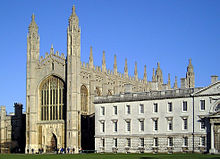King's College (Cambridge)
| The King's College of Our Lady and St Nicholas | |
|---|---|

|
|
| founding | 1441 |
| Sponsorship | University of Cambridge |
| place | Cambridge |
| Provost | Ross Harrison |
| Students | 397 postgraduates : 239 |
| Website | www.kings.cam.ac.uk |
The King's College is a college of the University of Cambridge , England , United Kingdom of Great Britain and Northern Ireland. It was founded in 1441 by King Henry VI. founded. Over the past few centuries the college has gradually opened up and is now one of the most progressive in Cambridge.
coat of arms
The coat of arms was awarded to King's College in 1449. It shows a golden lily on a blue background and a golden lion on a red background, both taken from the coat of arms of the founder Henry VI, which in turn combined the coats of arms of the English and French kings. The three silver roses symbolize the scholarship in honor of God and the Virgin Mary , one of the patrons of the college, the black background stands for persistence.
history
King's College was founded on February 12, 1441 by Henry VI. founded, originally only for twelve students in need. On Easter Sunday, April 2, 1441, the king himself laid the foundation stone for the Old Court in the garden of Trinity Hall . The college was dedicated to the Virgin Mary and Saint Nicholas of Myra . The first principal and initially only teacher was William Millington, a fellow at Clare College . The choir was also founded in 1441 , and its main task to this day is to sing at the services and prayers of the hours in King's College Chapel .
With a new founding document from July 12, 1443, Heinrich VI expanded. his plans: The new college should now accommodate 70 scholars and fellows. The students were selected annually from the best students at Eton College , which in 1440 also by Henry VI. Founded. The college members graduated after three years of study without university exams . The majority of the graduates were required to study theology and receive ordination.
Since the original construction plans were not sufficient for this number of students, the king drafted a new plan with a chapel as the north side of the courtyard. He laid the foundation stone of King's College Chapel on July 25, 1446 south of the already completed Old Court building. With the deposition of Heinrich VI. construction was interrupted in the Wars of the Roses . The chapel was the only part of this plan that was completed by 1515 under the Tudor kings Henry VII and Henry VIII .
In 1724, James Gibbs designed three new classicist side wings for that of Henry VI. planned courtyard, of which only the western wing was built. It was not until 1828 that the new courtyard, the Front Court, was completed under William Wilkins in the neo-Gothic style . The Old Court was sold to the university and demolished to make way for a new library.
In 1851 the old privilege of graduation without an examination was revoked. In 1861 the number of college members was increased by 24. Undergraduates from schools other than Eton were also admitted for the first time. Further buildings were erected. In 1972 King's College was one of the first Cambridge colleges to accept women.
King's College Chapel
The King's College Chapel is commonly seen as the symbol of the city and is perhaps the most famous buildings of Gothic architecture in Cambridge. It was built in three stages over a period of around 100 years and has the largest fan vault in the world (in the typical perpendicular style ), many church windows and the painting "The Adoration of the Magi from the Orient" by Peter Paul Rubens . The chapel continues to be actively used for church services and some other college events. The Festival of Nine Lessons and Carols takes place there every year on Christmas Eve .
Alumni
- Laurence Saunders (1519–1555), clergyman and evangelical martyr
- Francis Walsingham (1532–1590), founder of the English secret service
- Sir John Harington (1561–1612), statesman and inventor of the toilet flush
- Orlando Gibbons (1583–1625), composer
- Sir Robert Walpole (1676–1745), first Prime Minister of Great Britain
- Edward Morgan Forster (1879-1970), writer
- John Maynard Keynes (1883–1946), English mathematician and economist
- Alan Turing (1912–1954), mathematician and one of the forefathers of the computer
- Robin Milner (1934-2010), Turing Prize Winner for ML and Automatic Proofing
- Andrew Davis (* 1944), conductor
- Salman Rushdie (born 1947), writer
- Joseph Deiss (* 1946), former Swiss Minister of Economic Affairs / 2010 President of the UN General Assembly
- Tony Judt (1948-2010), historian
- Julien Temple (born 1953), film director
- Eleanor Sharpston (* 1955), Advocate General at the European Court of Justice
- Sir John Dermot Turing (born 1961), British lawyer, banker, author and historian, nephew of Alan Turing
- Zadie Smith (* 1975), writer
Web links
Individual evidence
Coordinates: 52 ° 12 ′ 15 ″ N , 0 ° 7 ′ 0 ″ E



